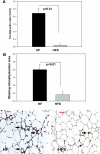Dipeptidyl peptidase IV inhibitor sitagliptin reduces local inflammation in adipose tissue and in pancreatic islets of obese mice
- PMID: 21081706
- PMCID: PMC3043624
- DOI: 10.1152/ajpendo.00463.2010
Dipeptidyl peptidase IV inhibitor sitagliptin reduces local inflammation in adipose tissue and in pancreatic islets of obese mice
Abstract
Adipose tissue inflammation and reduced pancreatic β-cell function are key issues in the development of cardiovascular disease and progressive metabolic dysfunction in type 2 diabetes mellitus. The aim of this study was to determine the effect of the DPP IV inhibitor sitagliptin on adipose tissue and pancreatic islet inflammation in a diet-induced obesity model. C57Bl/6J mice were placed on a high-fat (60% kcal fat) diet for 12 wk, with or without sitagliptin (4 g/kg) as a food admix. Sitagliptin significantly reduced fasting blood glucose by 21% as well as insulin by ∼25%. Sitagliptin treatment reduced body weight without changes in overall body mass index or in the epididymal and retroperitoneal fat mass. However, sitagliptin treatment led to triple the number of small adipocytes despite reducing the number of the very large adipocytes. Sitagliptin significantly reduced inflammation in the adipose tissue and pancreatic islet. Macrophage infiltration in adipose tissue evaluated by immunostaining for Mac2 was reduced by sitagliptin (P < 0.01), as was the percentage of CD11b+/F4/80+ cells in the stromal vascular fraction (P < 0.02). Sitagliptin also reduced adipocyte mRNA expression of inflammatory genes, including IL-6, TNFα, IL-12(p35), and IL-12(p40), 2.5- to fivefold as well as 12-lipoxygenase protein expression. Pancreatic islets were isolated from animals after treatments. Sitagliptin significantly reduced mRNA expression of the following inflammatory cytokines: MCP-1 (3.3-fold), IL-6 (2-fold), IL-12(p40) (2.2-fold), IL-12(p35) (5-fold, P < 0.01), and IP-10 (2-fold). Collectively, the results indicate that sitagliptin has anti-inflammatory effects in adipose tissue and in pancreatic islets that accompany the insulinotropic effect.
Figures









Similar articles
-
Dipeptidyl peptidase IV inhibition activates CREB and improves islet vascularization through VEGF-A/VEGFR-2 signaling pathway.PLoS One. 2013 Dec 11;8(12):e82639. doi: 10.1371/journal.pone.0082639. eCollection 2013. PLoS One. 2013. PMID: 24349326 Free PMC article.
-
Sitagliptin reduces plaque macrophage content and stabilises arteriosclerotic lesions in Apoe (-/-) mice.Diabetologia. 2012 Aug;55(8):2267-75. doi: 10.1007/s00125-012-2582-5. Epub 2012 May 18. Diabetologia. 2012. PMID: 22648661
-
Valsartan protects pancreatic islets and adipose tissue from the inflammatory and metabolic consequences of a high-fat diet in mice.Hypertension. 2010 Mar;55(3):715-21. doi: 10.1161/HYPERTENSIONAHA.109.148049. Epub 2010 Jan 25. Hypertension. 2010. PMID: 20100990 Free PMC article.
-
Sitagliptin: Profile of a novel DPP-4 inhibitor for the treatment of type 2 diabetes.Drugs Today (Barc). 2007 Jan;43(1):13-25. doi: 10.1358/dot.2007.43.1.1043909. Drugs Today (Barc). 2007. PMID: 17315049 Review.
-
Sitagliptin: profile of a novel DPP-4 inhibitor for the treatment of type 2 diabetes (update).Drugs Today (Barc). 2007 Nov;43(11):801-14. doi: 10.1358/dot.2007.43.11.1157620. Drugs Today (Barc). 2007. PMID: 18174966 Review.
Cited by
-
Whey protein hydrolysates improve high-fat-diet-induced obesity by modulating the brain-peripheral axis of GLP-1 through inhibition of DPP-4 function in mice.Eur J Nutr. 2023 Sep;62(6):2489-2507. doi: 10.1007/s00394-023-03162-4. Epub 2023 May 8. Eur J Nutr. 2023. PMID: 37154934
-
Beneficial Effects of Evogliptin, a Novel Dipeptidyl Peptidase 4 Inhibitor, on Adiposity with Increased Ppargc1a in White Adipose Tissue in Obese Mice.PLoS One. 2015 Dec 3;10(12):e0144064. doi: 10.1371/journal.pone.0144064. eCollection 2015. PLoS One. 2015. PMID: 26633898 Free PMC article.
-
GLP-1-dependent and independent effects and molecular mechanisms of a dipeptidyl peptidase 4 inhibitor in vascular endothelial cells.Mol Biol Rep. 2013 Mar;40(3):2273-9. doi: 10.1007/s11033-012-2290-8. Epub 2012 Nov 28. Mol Biol Rep. 2013. PMID: 23187735
-
Sitagliptin Reduces Inflammation and Chronic Immune Cell Activation in HIV+ Adults With Impaired Glucose Tolerance.J Clin Endocrinol Metab. 2015 Jul;100(7):2621-9. doi: 10.1210/jc.2015-1531. Epub 2015 May 4. J Clin Endocrinol Metab. 2015. PMID: 25938633 Free PMC article. Clinical Trial.
-
Characterization of dedifferentiating human mature adipocytes from the visceral and subcutaneous fat compartments: fibroblast-activation protein alpha and dipeptidyl peptidase 4 as major components of matrix remodeling.PLoS One. 2015 Mar 27;10(3):e0122065. doi: 10.1371/journal.pone.0122065. eCollection 2015. PLoS One. 2015. PMID: 25816202 Free PMC article.
References
-
- Aaboe K, Knop FK, Vilsboll T, Deacon CF, Holst JJ, Madsbad S, Krarup T. Twelve weeks treatment with the DPP-4 inhibitor, sitagliptin, prevents degradation of peptide YY and improves glucose and non-glucose induced insulin secretion in patients with type 2 diabetes mellitus. Diabetes Obes Metab 12: 323–333, 2010 - PubMed
-
- Ahren B. Dipeptidyl peptidase-4 inhibitors: clinical data and clinical implications. Diabetes Care 30: 1344–1350, 2007 - PubMed
-
- Ahren B, Holst JJ, Martensson H, Balkan B. Improved glucose tolerance and insulin secretion by inhibition of dipeptidyl peptidase IV in mice. Eur J Pharmacol 404: 239–245, 2000 - PubMed
-
- Allen TL, Febbraio MA. IL6 as a mediator of insulin resistance: fat or fiction? Diabetologia 53: 399–402, 2010 - PubMed
-
- Andersson CX, Gustafson B, Hammarstedt A, Hedjazifar S, Smith U. Inflamed adipose tissue, insulin resistance and vascular injury. Diabetes Metab Res Rev 24: 595–603, 2008 - PubMed
Publication types
MeSH terms
Substances
Grants and funding
LinkOut - more resources
Full Text Sources
Other Literature Sources
Research Materials
Miscellaneous

